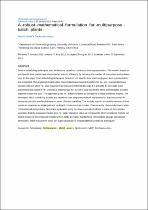JavaScript is disabled for your browser. Some features of this site may not work without it.
- ResearchSpace
- →
- Research Publications/Outputs
- →
- Journal Articles
- →
- View Item
| dc.contributor.author |
Seid, R

|
|
| dc.contributor.author |
Majozi, T

|
|
| dc.date.accessioned | 2011-12-09T10:34:31Z | |
| dc.date.available | 2011-12-09T10:34:31Z | |
| dc.date.issued | 2012-01 | |
| dc.identifier.citation | Seid, R and Majozi, T. 2012. Robust mathematical formulation for multipurpose batch plants. Chemical Engineering Science, Vol 68(1), pp 36-53 | en_US |
| dc.identifier.issn | 0009-2509 | |
| dc.identifier.uri | http://www.sciencedirect.com/science/article/pii/S0009250911006191 | |
| dc.identifier.uri | http://hdl.handle.net/10204/5377 | |
| dc.description | Copyright: 2011 Elsevier. This is an ABSTRACT ONLY | en_US |
| dc.description.abstract | Several scheduling techniques exist in literature based on continuous time representation. The models based on unit specific time points have shown better solution efficiency by reducing the number of time points and problem size. In this paper novel scheduling techniques based on unit specific time point continuous time representation are presented. The proposed models allow nonsimultaneous material transfer into a unit. Nonsimultaneous transfer refers to when a task requires more than one intermediate state it is possible for one state to be transferred and stored in a unit that is processing it for a while and wait for the other intermediates to come together to start the task. This approach gives a better schedule as compared to most published models. The developed MILP scheduling models are based on state sequence network representation that has proven to inherently result in smaller problems in terms of binary variables. The models require a smaller number of time points as compared to single-grid and multi-grid continuous time models. Consequently, they exhibit much better computational performance. Numerical evaluation using literature examples indicate in some of the complex examples that the proposed models give a better objective value as compared to other scheduling models. An added feature of the proposed models is their ability to exactly handle fixed intermediate storage operational philosophy, which has proven to be a subtle drawback in most published scheduling techniques. | en_US |
| dc.language.iso | en | en_US |
| dc.publisher | Elsevier | en_US |
| dc.relation.ispartofseries | Workflow request;7602 | |
| dc.subject | Scheduling techniques | en_US |
| dc.subject | Batch plants | en_US |
| dc.subject | Mixed integer linear programming | en_US |
| dc.subject | Chemical engineering science | en_US |
| dc.title | A robust mathematical formulation for multipurpose batch plants | en_US |
| dc.type | Article | en_US |
| dc.identifier.apacitation | Seid, R., & Majozi, T. (2012). A robust mathematical formulation for multipurpose batch plants. http://hdl.handle.net/10204/5377 | en_ZA |
| dc.identifier.chicagocitation | Seid, R, and T Majozi "A robust mathematical formulation for multipurpose batch plants." (2012) http://hdl.handle.net/10204/5377 | en_ZA |
| dc.identifier.vancouvercitation | Seid R, Majozi T. A robust mathematical formulation for multipurpose batch plants. 2012; http://hdl.handle.net/10204/5377. | en_ZA |
| dc.identifier.ris | TY - Article AU - Seid, R AU - Majozi, T AB - Several scheduling techniques exist in literature based on continuous time representation. The models based on unit specific time points have shown better solution efficiency by reducing the number of time points and problem size. In this paper novel scheduling techniques based on unit specific time point continuous time representation are presented. The proposed models allow nonsimultaneous material transfer into a unit. Nonsimultaneous transfer refers to when a task requires more than one intermediate state it is possible for one state to be transferred and stored in a unit that is processing it for a while and wait for the other intermediates to come together to start the task. This approach gives a better schedule as compared to most published models. The developed MILP scheduling models are based on state sequence network representation that has proven to inherently result in smaller problems in terms of binary variables. The models require a smaller number of time points as compared to single-grid and multi-grid continuous time models. Consequently, they exhibit much better computational performance. Numerical evaluation using literature examples indicate in some of the complex examples that the proposed models give a better objective value as compared to other scheduling models. An added feature of the proposed models is their ability to exactly handle fixed intermediate storage operational philosophy, which has proven to be a subtle drawback in most published scheduling techniques. DA - 2012-01 DB - ResearchSpace DP - CSIR KW - Scheduling techniques KW - Batch plants KW - Mixed integer linear programming KW - Chemical engineering science LK - https://researchspace.csir.co.za PY - 2012 SM - 0009-2509 T1 - A robust mathematical formulation for multipurpose batch plants TI - A robust mathematical formulation for multipurpose batch plants UR - http://hdl.handle.net/10204/5377 ER - | en_ZA |






